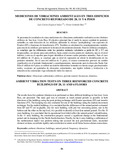Mostrar el registro sencillo del ítem
Mediciones de vibraciones ambientales en tres edificios de concreto reforzado de 28, 11 y 6 pisos
| dc.creator | Esquivel Salas, Luis Carlos | |
| dc.creator | Schmidt Díaz, Víctor | |
| dc.date.accessioned | 2021-11-18T13:55:09Z | |
| dc.date.available | 2021-11-18T13:55:09Z | |
| dc.date.issued | 2016-11-21 | |
| dc.identifier.citation | https://www.smis.mx/index.php/RIS/article/view/RIS-95-4 | |
| dc.identifier.issn | 2395-8251 | |
| dc.identifier.uri | https://hdl.handle.net/10669/85257 | |
| dc.description.abstract | Se presentan los resultados de cinco mediciones de vibraciones ambientales realizadas en tres distintos edificios de San José, Costa Rica. El objetivo principal fue el medir la mayor cantidad de periodos naturales en cada dirección de los edificios utilizando la técnica “peak-picking” con espectros de Fourier (EF) y funciones de transferencia (FT). También se calcularon los amortiguamientos modales para uno de los edificios por medio de la técnica de decaimiento aleatorio. Para los edificios estudiados, se concluye que las diferencias entre los periodos naturales calculados a partir de EF y FT son despreciables, así mismo para cada edificio, basta contar con dos puntos de medición, uno en el nivel inferior y otro en el superior para lograr identificar al menos cuatro periodos naturales. Para el caso del edificio de 28 pisos, se concluye que su nivel de operación no afectó la identificación de los periodos naturales. En el caso del edificio de 11 pisos, el avance constructivo provocó un cambio significativo en el periodo fundamental y amortiguamiento, únicamente para la dirección Norte-Sur. Para el edificio de 6 pisos se calibró un modelo matemático tomando en cuenta cargas gravitacionales reales, secciones no agrietadas de elementos estructurales, una rigidez infinita y restricción a la rotación en las conexiones viga-columna de todos los marcos. | es_ES |
| dc.description.abstract | The results from five ambient vibration tests performed on three different buildings in San José, Costa Rica, are presented. The main goal was to estimate as much natural periods as possible in both directions of the buildings using the peak picking technique with Fourier spectrums (EF) and transfer functions (FT). The damping was also estimated for one of the buildings using the random decrement technique. For the studied buildings, it is concluded that the differences of the natural periods estimated from EF and FT are negligible, also for each building, with just two measuring points, one in the bottom and the other on the top level, it is possible to identify at least four natural periods. For the 28 story building, it is concluded that its operational level didn't affect the natural period’s identification. In the 11 story building, the construction progress caused a significant change in the fundamental period and its damping for the North-South direction. Finally, for the 6 story building a calibration of the mathematical model was perform taking into account the real gravitational loads, uncracked element sections, an infinite rigidity and a restriction to rotate on all frame beam-column connections. | es_ES |
| dc.language.iso | spa | es_ES |
| dc.source | Revista de Ingeniería Sísmica, vol. 95, pp.81-103 | es_ES |
| dc.subject | vibraciones ambientales | es_ES |
| dc.subject | periodo natural | es_ES |
| dc.subject | frecuencia natural | es_ES |
| dc.subject | edificios | es_ES |
| dc.subject | acelerógrafos | es_ES |
| dc.subject | dinámica | es_ES |
| dc.subject | ambient vibrations | es_ES |
| dc.subject | buildings | es_ES |
| dc.subject | natural period | es_ES |
| dc.subject | frequency | es_ES |
| dc.subject | dynamics | es_ES |
| dc.title | Mediciones de vibraciones ambientales en tres edificios de concreto reforzado de 28, 11 y 6 pisos | es_ES |
| dc.title.alternative | Ambient vibration tests on three reinforced concrete buildings of 28, 11 and 6 floors | es_ES |
| dc.type | artículo original | |
| dc.identifier.doi | 10.18867/ris.95.391 | |
| dc.description.procedence | UCR::Vicerrectoría de Investigación::Unidades de Investigación::Ingeniería::Instituto Investigaciones en Ingeniería (INII) | es_ES |
Ficheros en el ítem
Este ítem aparece en la(s) siguiente(s) colección(ones)
-
Ingeniería civil [701]


